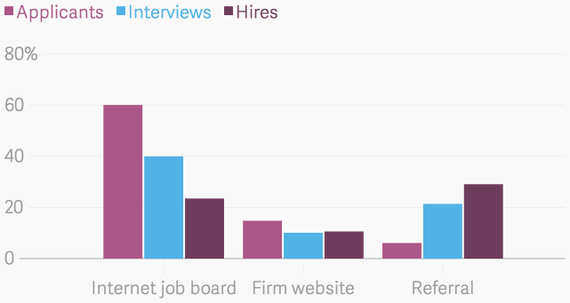
More than ever, people are opting out of clocking in at the office and are working from their own turf instead. One in five workers across the globe telecommute from outside the workplace, many of them from the comfort of their homes, according to a recent Ipsos poll for Reuters.
While it can be easy to imagine telecommuters slacking off because they can, a recent Stanford University research suggests the opposite, revealing that working remotely actually makes employees up to 13 percent more productive — because they enjoy more job satisfaction. Chances are, employers of telecommuters are generally happier, too, and for quite a few good reasons, says Sara Sutton Fell, founder of the job site FlexJobs.com.
“Hiring telecommuters can help small and medium businesses expand into new territories and markets without setting up new office space,” says Fell. In addition to trimming office-related operating costs, the increasingly common practice can also significantly reduce burnout and turnover.
Here are 10 important questions to ask when hiring your first telecommuter:
1. How can I be sure the candidate is truly qualified for the job?
The hiring process for a telecommuter doesn’t have to be all that different than vetting an office worker, Fell says. How you screen them depends on your own personal interviewing style.
For example, Fell feels most comfortable doing her hiring via phone interview. If you prefer vetting potential hires face-to-face but can’t meet in-person, consider a meeting via Facetime, Skype or a similar videoconferencing tool.
After the initial interview or interviews, Fell suggests literally putting the candidate to the test at whatever skill or job function you expect him or her to perform. For example, when she hires writers, she asks them to draft a sample article. When her company brings on job researchers, she assigns them a research assignment.
You’ll also want to check a candidate’s government-issued identification and run a routine background check to verify his or her identity, and to weed out potentially untrustworthy types.
2. Who provides the equipment the candidate needs for work? Me or the telecommuter?
There are no real rules when it comes to equipment and office space, Fell says. List the specific types of technology the individual might require to fulfill his or her duties — perhaps Wi-Fi service and routers, laptops, landline, smartphones, printers, ink and any other equipment you would provide your in-office employees with — then add up the costs and see if you can budget for them. If not, your telecommuter might have to foot the equipment bill.
Flexjobs is a “Bring Your Own Device” employer and routinely asks its employees to provide their own work-related technology, though it does offer a stipend to help ease costs. Fell cautions that people who work from home shouldn’t expect you to pay their household utility expenses, like heat and electricity.
3. What happens if the candidate experiences technical difficulties on the job? How do I know he or she can handle it?
For extra reassurance, you can simply ask the person during the interview how he or she would handle specific scenarios that might affect the various technology their performance depends on, Fell suggests. To minimize roadblocks, train the person on any software and web-based tools they’ll need, if possible.
If the person’s home Wi-Fi is too slow or goes down, is the individual willing to relocate to a nearby Wi-Fi-enabled cafe, library or co-working space? Does the person know how to take and share a screenshot of a software error? Or, if a more complicated IT snafu occurs, does he or she have the communication skills to troubleshoot the problem with your company’s tech support team?
4. What’s the best way to communicate with an employee who works off-site?
It boils down to trial and error, Fell says. Test different options, including instant messaging, email, phone and videoconferencing options, and see what’s most effective for both parties.
How often you communicate with your telecommuter — hourly, daily, monthly — is up to you and depends on what they do for you. Fell advises using Join.Me (free trial, starting at $13 per month), an online meeting tool that her team relies on, for check-in meetings and web conference calls at least once a week.
Fell’s employees also chat together company-wide via Yammer (free basic option, $3 per user per month for advanced features, security and support), an enterprise social network app that’s like Facebook, only for work. For daily impromptu communication, Fell prefers emailing and instant messaging. And, of course, the phone, the old standby, is the most effective for quickly talking things through that might not otherwise come across clearly in written language.
5. How can I track the progress of my telecommuter’s projects?
Google Drive, a free, cloud-based document processing and storage tool, is an all-in-one solution for creating, editing and sharing documents, presentations and spreadsheets. Dropbox (14-day free trial, $15 per user per month with annual pricing options) can be ideal for storing and sharing large files in the cloud.
For seamless individual and group project management and goal-tracking, Fell suggests the user-friendly Pivotal Tracker (free 60-day trial, startup options range from $7 to $18 per month, pro options from $50 to $175 per month, depending on the number of collaborators).
6. How can I include the telecommuter I hire in our company culture?
You can occasionally invite the person to take part in office parties and holiday celebrations, if he or she lives within driving distance to your office. Also, regularly include him or her in group discussions over the phone and via videoconferencing apps when possible.
Hearing and seeing each other in real time can help develop a friendly rapport that might be difficult to achieve with text-based communications. If you want the employee to be a core contributing member on your team for the long haul, take the time and effort to make him or her feel welcome.
7. Should I create a written company telecommuting policy?
Without a doubt yes, Fell says. “A telecommuting policy is a much-needed way to make sure that everyone is on the same page in terms of expectations.” It should be tailored to individual telecommuters and specify exactly what tasks and responsibilities are expected of them when and how often.
Your policy should also thoroughly address work hours. Are telecommuters required to work during your company’s set business hours or will they have a flexible schedule that they can determine themselves? Also be sure to address management oversight, says Fell. How often will managers check in with telecommuters and vice versa? Also spell out what your requirements are for internet speed and connectivity, technology and equipment.
8. Is there more I can do to keep tabs on telecommuters?
Unfortunately you won’t always know for sure what your teleworker is up to when you can’t physically see the person. That’s why hiring telecommuters requires a significant leap of faith, not to mention trust.
Referencing a recent study by Life Meets Work, Inc. and the Boston College Center for Work and Family, Fell says that “pretty much any manager can successfully manage a telecommuting workforce if they’re given the proper tools.” Make sure you have all of the tech and communication tools you need — as described in detail above — to feel confident that you’ll be up to properly tracking and evaluating your telecommuters contributions, both short- and long-term.
9. What if the candidate has young children?
To minimize potential parenting-related work distractions, downtime and time off, Fell suggests confirming that the candidate has adequate childcare solutions in place during his or her work hours.
“It’s simply impossible to be able to focus both on your work and your children at the same time,” she says. “It’s not good for either of them, and you wind up feeling stressed, stretched and unproductive in both areas.”
Still, she says employers should be reasonably flexible should emergency situations pop up that cause children to be home without childcare, including snow days and serious illness.
10. What are some common pitfalls to avoid?
Fell says the biggest mistake business owners make when allowing employees to work from home is failing to “adjust their management techniques for a telecommuting population.”
“Managers need to be a bit more hands-on with telecommuters because they can’t simply walk by their desk and see what they’re up to,” she says.
Have something to add to this story? Share it in the comments.
Image by Shutterstock
Article by Kim Lachance Shandrow
This story originally appeared on entrepreneur.com











